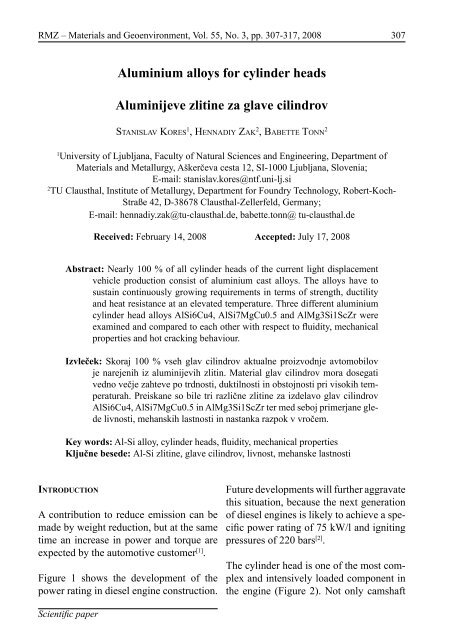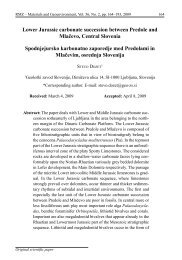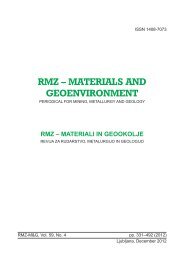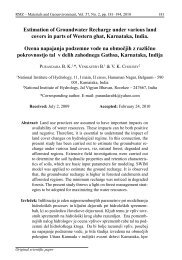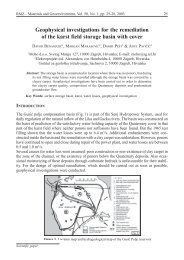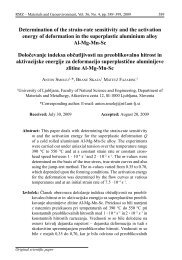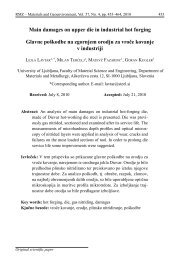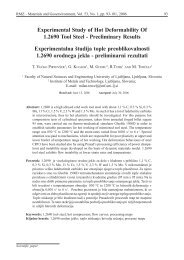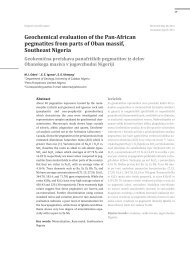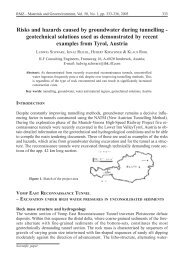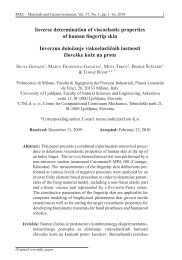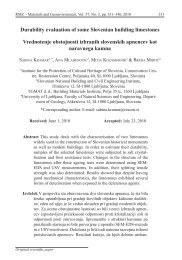Aluminium alloys for cylinder heads Aluminijeve zlitine za ... - RMZ
Aluminium alloys for cylinder heads Aluminijeve zlitine za ... - RMZ
Aluminium alloys for cylinder heads Aluminijeve zlitine za ... - RMZ
Create successful ePaper yourself
Turn your PDF publications into a flip-book with our unique Google optimized e-Paper software.
308 Ko r e s, S., Za k, H., To n n, B.Figure 1. Development of the power rating and peak pressure in a car diesel engine [2]Slika 1. Razvoj rasti moči in tlaka v avtomobilih z dizelskim motorjem [2]Figure 2. Cylinder head [3]Slika 2. Glava cilindra [3]<strong>RMZ</strong>-M&G 2008, 55
<strong>Aluminium</strong> <strong>alloys</strong> <strong>for</strong> <strong>cylinder</strong> <strong>heads</strong>311Definition of FluidityFluidity is a material characteristic, tellinghow far a metal can flow in the mould anddepends not only on the alloy’s characteristicsbut also on the mould properties suchas dimension, geometry, material, initialmould temperature, pouring temperature,etc. It is usually assessed as the total lengthof the branches filled with metal after solidification[6] . In this research an aluminiumspiral mould heated up to 100 °C <strong>for</strong>determining the fluidity was used (Figure5). The length of the spiral in cm after theexperiment was measured.Figure 5. Mould <strong>for</strong> investigation of fluiditySlika 5. Kokila <strong>za</strong> merjenje livnostiMechanical PropertiesTo study the mechanical properties a test specimenwas used which was cast into a mouldfrom gray cast iron according to DIN 29531(Figure 6). The mould temperature was 300°C. This mould provides castings that must bemachined to the dimensions shown in Table 2.The tensile strength, yield strength and elongationwere defined with tensile tests.All <strong>alloys</strong> were T6 heat treated. Table 3shows the heat treatment <strong>for</strong> each alloy.The samples were solution heat treated,quenched and hot age-hardened.Table 2. Dimension of tensile test specimensTabela 2. Dimenzija vzorca <strong>za</strong> natezni preizkusSpecimensdiameterd 0[mm]<strong>RMZ</strong>-M&G 2008, 55Coild 1[mm]Head heighth [mm]MeasurementlengthL 0[mm]Search lengthL V[mm]Total lengthL T[mm]6 M10 8 30 36 60
<strong>Aluminium</strong> <strong>alloys</strong> <strong>for</strong> <strong>cylinder</strong> <strong>heads</strong>313Table 5 shows the results of fluidity investigation.The best fluidity results showAlSi7MgCu0.5 alloy followed by AlMg-3Si1ScZr and AlSi6Cu4 <strong>alloys</strong>.Table 5. Fluidity of investigated <strong>alloys</strong>Tabela 5. Livnost preiskovanih zlitinAlloyLength [cm]AlSi7MgCu0,5 64.8AlSi6Cu4 43.2AlMg3Si1ScZr 52.5The results of the tensile tests measured atroom temperature are presented in Figures7-9. Figure 7 evidently shows, that commercial<strong>alloys</strong>, AlSi6Cu4 and AlSi7MgCu0.5and the newly developed AlMg3Si1ScZralloy achieve similar values<strong>for</strong> tensile strength in as cast condition.After heat treatment the values <strong>for</strong> tensilestrength of AlSi6Cu4 alloy rises to408 MPa, AlSi7MgCu0.5 to 318 MPa andAlMg3Si1ScZr to 251 MPa.Figure 7. Tensile strength of investigated <strong>alloys</strong>, measured at room temperature(F – as-cast, T6 – heat treated)Slika 7. Natezna trdost preiskovanih zlitin, merjena pri sobni temperature (F – litostanje, T6 – toplotno obdelano stanje)Figure 8 presents the yield strength of theinvestigated <strong>alloys</strong>. The AlSi6Cu4 alloyhas a yield point of 136 MPa in as-castcondition. After heat treatment the yieldpoint rises to 383 MPa. The yield point <strong>for</strong>AlMg3Si1Sc1Zr is 23 MPa higher then Al-Si7MgCu0,5 in as-cast condition. But theyield point after heat treatment of the Al-<strong>RMZ</strong>-M&G 2008, 55Si7MgCu0.5 alloy is higher than the AlMg3Si1ScZralloy.Figure 9 depicts the elongation of theinvestigated <strong>alloys</strong>. Obviously the bestresults in as-cast conditions showed theAlSi7MgCu0.5 alloy with an elongation of6 %. After the heat treatment an increase of
314 Ko r e s, S., Za k, H., To n n, B.elongation values of 8.7 % can be detected.The AlMg3Si1ScZr alloy shows the bestresults after heat treatment with 10.7 %.The high strength AlSi6Cu4 alloy showsthe poorest ductility.The results of tensile tests at 250 °C of theinvestigated <strong>alloys</strong> are shown in Figure 10.The newly developed alloy AlMg3Si1SCZrshows by far the best elongation results with16 % at 250 °C. But the tensile strength andyield strength of this alloy are comparablewith commercial AlSi7MgCu0.5 alloy. Thebest tensile strength and yield strength resultsshow AlSi6Cu4 alloy.After pre-aging 100 hours at 250 °C thematerial per<strong>for</strong>mance at 250 °C is quitdifferent. This test simulates the workingcondition in a <strong>cylinder</strong> head <strong>for</strong> along period of time. Figure 11 evidentlyshows that AlMg3Si1ScZr alloy hasthe best results of all three investigated<strong>alloys</strong>. This alloy achieves a tensilestrength of 251 MPa and the highestyield strength of 162 MPa.Figure 8. Yield strength of investigated <strong>alloys</strong>, measured at room temperature (F– as-cast, T6 – heat treated)Slika 8. Meja tečenja preiskovanih zlitin, merjena pri sobni temperature (F – litostanje, T6 – toplotno obdelano stanje)<strong>RMZ</strong>-M&G 2008, 55
<strong>Aluminium</strong> <strong>alloys</strong> <strong>for</strong> <strong>cylinder</strong> <strong>heads</strong>315Figure 9. Elongation of investigated <strong>alloys</strong>, measured at room temperature (F –as-cast, T6 – heat treated)Slika 9. Raztezek preiskovanih zlitin, merjen pri sobni temperature (F – lito stanje,T6 – toplotno obdelano stanje)Figure 10. Tensile strength, yield strength and elongation of T6- heat treated<strong>alloys</strong> tested at 250 °CSlika 10. Natezna trdnost, meja tečenja in raztezek T6 toplotno obdelanih zlitin,preizkus pri 250 °C<strong>RMZ</strong>-M&G 2008, 55
316 Ko r e s, S., Za k, H., To n n, B.Figure 11. Tensile strength, yield strength and elongation T6-heat treated <strong>alloys</strong>tested at 250 °C, pre-aging 100 hours at 250 °CSlika 11. Natezna trdnost, meja tečenja in raztezek T6 toplotno obdelanih zlitinstaranih 100 ur na 250 °C, preizkus pri 250 °CCo n c l u s i o n sThe AlMg3Si1ScZr alloy shows the bestcompromise of ductility and mechanicalproperties at 250 °C after pre-aging 100hours at 250 °C, but it also shows the worsthot-tearing behaviour. The addition of Sc andZr to the AlMg3Si1 base alloy has a positiveeffect on the mechanical properties, but onthe other hand raises costs, which must beaccepted by the industry. If 0.2 wt. % Sc isadded to an alloy it will increase materialcost to US$5/kg which, depending on thealloy, represents a doubling to quadruplingof the material cost [7] .The excellent tensile properties, fluidityand resistance to hot-tearing, allows thewell known AlSi6Cu4 and AlSi7MgCu0.5<strong>alloys</strong> to retain their leading position in theproduction of aluminium <strong>cylinder</strong> <strong>heads</strong> inthe near future.Po v z e t e k<strong>Aluminijeve</strong> <strong>zlitine</strong> <strong>za</strong> glave cilindrovGlave cilindrov so dan danes narejeneizrecno iz aluminijevih zlitin in so eneizmed najbolj obremenjenih komponent vmotorju. V tem delu so bile raziskane <strong>zlitine</strong><strong>za</strong> izdelavo glav cilindrov. Preiskovale inprimerjale so se dve poznani komercialnizlitini AlSi7MgCu0,5 in AlSi6Cu4 z novorazvito zlitino AlMg3Si1ScZr glede namehanske lastnosti pri sobni temperaturi,po toplotni obdelavi in preizkusu pri 250°C<strong>RMZ</strong>-M&G 2008, 55
<strong>Aluminium</strong> <strong>alloys</strong> <strong>for</strong> <strong>cylinder</strong> <strong>heads</strong>317in po 100 urnem staranju na 250°C inpreizkusu pri 250°C. Preiskovale so se tudilivarske lastnosti, kot so nastank razpok vvročem in livnost zlitin. Pri mehanskihlastnostih so se opazovale natezna trdnost,meja tečenja in raztezek <strong>zlitine</strong>. Zlitine sobile ulite v <strong>za</strong>to pripravljeno kokilo iz sivelitine po standardu DIN 29531. Ulitek seje nato obdelal na dimenzije <strong>za</strong> nateznipreizkus. Nastanek razpok se je opazovalos pomočjo zvezdaste kokile. Kokila jebila opremljena z petimi različno dolgimipalicami katerih konci so odebeljeni.Pri strjevanju prihaja do krčenja in <strong>za</strong>todo napetosti, kar posledica so razpoke.Razpoke so bile razdeljene v štiri razredeter jim dodeljene vrednosti, in sicer indeks1 <strong>za</strong> popolnoma odlomljeno palico, indeks0,75 <strong>za</strong> razpoko, ki je potekala okrogpalice, 0,5 <strong>za</strong> razpoko, ki je bila takovelika, da je bila vidna s prostim očesomin 0,25 <strong>za</strong> razpoko, ki je bila vidna le podpovečevalnim steklom. Vsi indeksi so bilinato sešteti in dobljen je bil indeks nastankarazpok v vročem. Livnost se je določevalas pomočjo spiralaste kokile. Kokila je bilaizdelana iz aluminija in ob vsakem litjuogreta na 100 °C. Po končanem preizkusuje bila izmerjena dolžina spirale.Zlitina AlMg3Si1ScZr je poka<strong>za</strong>la najboljšokombinacijo duktilnosti in mehanskihlastnosti pri 250 °C po 100 urnem staranjuna 250 °C, vendar tudi visok indeksnastanka razpok v vročem. Dodatka Sc inZr imata pozitiven učinek na mehanskelastnosti, vendar prinašata visoke stroške,kar mora biti sprejeto s strani industrije.Dodatek 0,2 ut. % Sc zlitini poveča ceno<strong>zlitine</strong> <strong>za</strong> 5 $/kg.Odlične lastnosti pri nateznem preizkusu,livnost in obstojnost v vročem, prinašajozlitinam AlSi6Cu4 in AlSi7MgCu0,5 vodilnomesto pri proizvodnji aluminijastihglav cilindrov v bližnji prihodnosti.Re f e r e n c e s[1]Sc h n e id e r, W. (2005): Highly stressedautomotive engines of aluminiumChallenges <strong>for</strong> the casting technologyand material development. Giesserei<strong>for</strong>schung57. No. 2, pp. 2-6.[2]Mn i c h, F., Se aw e rt, H.C., Ba h r, R.(2007): NDCS-a new process <strong>for</strong>manufacturing Al automotive castings.Casting, Plant and Technology.;No. 1, pp. 34-37.[3]VAW-IMCO, Guss und RecyclingGmbH, 3. Auflage, 2004.[4]Eigenfeld, K., Fr a n k e, A., Kl a n, S.,Ko c h, H., Le n c z o w s k i, B., Pflege,B. (2004): New developments inheat resistant aluminium castingmaterials. Casting Plant + TechnologyInternational.; No. 4, pp. 4-9.[5]<strong>Aluminium</strong> RHEINFELDEN, Ausgabe6, 5/94.[6]Vo j t e c h, D., Še r a k, J., Ek rt, O.(2004): Improving the castingproperties of high-strength aluminium<strong>alloys</strong>. Materials and Technology.;Vol. 38, No. 1-2.[7]Ro y s e t, J. (2007): Scandium in aluminium<strong>alloys</strong> overview: Physical metallurgy,properties and applications.Metallurgical Science and Technology.Vol. 25, No. 2, pp. 11-21.<strong>RMZ</strong>-M&G 2008, 55


